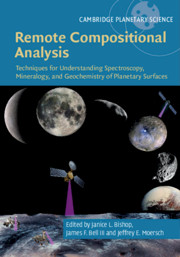 Remote Compositional Analysis
Remote Compositional Analysis Book contents
- Remote Compositional Analysis
- Cambridge Planetary Science
- Remote Compositional Analysis
- Copyright page
- Contents
- Contributors
- Foreword
- Preface
- Acknowledgments
- Part I Theory of Remote Compositional Analysis Techniques and Laboratory Measurements
- Part II Terrestrial Field and Airborne Applications
- Part III Analysis Methods
- 13 Effects of Environmental Conditions on Spectral Measurements
- 14 Hyper- and Multispectral Visible and Near-Infrared Imaging Analysis
- 15 Thermal Infrared Spectral Modeling
- 16 Geochemical Interpretations Using Multiple Remote Datasets
- Part IV Applications to Planetary Surfaces
- Index
- References
14 - Hyper- and Multispectral Visible and Near-Infrared Imaging Analysis
from Part III - Analysis Methods
Published online by Cambridge University Press: 15 November 2019
- Remote Compositional Analysis
- Cambridge Planetary Science
- Remote Compositional Analysis
- Copyright page
- Contents
- Contributors
- Foreword
- Preface
- Acknowledgments
- Part I Theory of Remote Compositional Analysis Techniques and Laboratory Measurements
- Part II Terrestrial Field and Airborne Applications
- Part III Analysis Methods
- 13 Effects of Environmental Conditions on Spectral Measurements
- 14 Hyper- and Multispectral Visible and Near-Infrared Imaging Analysis
- 15 Thermal Infrared Spectral Modeling
- 16 Geochemical Interpretations Using Multiple Remote Datasets
- Part IV Applications to Planetary Surfaces
- Index
- References
Summary
Multi- and hyperspectral sensors in the visible to short-wave infrared (0.4–2.5 μm) are sensitive to spectral features caused by electronic charge transfer and transition metal crystal field band as well as molecular overtone absorptions. This chapter reviews several processing techniques used to map materials on planetary surfaces based on their reflectance spectra in this spectral region. Techniques that are reviewed include spectral matching in the form of spectral angle and spectral information divergence, linear and nonlinear spectral unmixing, partial unmixing/matched filters, and machine learning approaches in the form of self-organizing maps, neural network classification, and support vector machines.
Keywords
Information
- Type
- Chapter
- Information
- Remote Compositional AnalysisTechniques for Understanding Spectroscopy, Mineralogy, and Geochemistry of Planetary Surfaces, pp. 307 - 323Publisher: Cambridge University PressPrint publication year: 2019
References
Accessibility standard: Unknown
Why this information is here
This section outlines the accessibility features of this content - including support for screen readers, full keyboard navigation and high-contrast display options. This may not be relevant for you.Accessibility Information
- 2
- Cited by